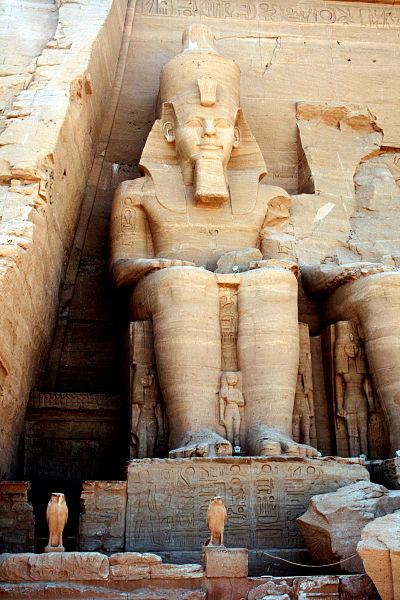Abu Simbel in Egypt is a site containing two magnificent temples, carved in rock, that were built for the pharaoh Ramses II. Abu Simbel is on the west bank of Lake Nasser, in Nubia, near the border with Sudan.
The Temple of Ramses, the larger of the two temples, is considered one of the ancient world's greatest architectural works.
This temple was carved into the side of a mountain between 1244 and 1224 BCE (BC). It was built to commemorate Egypt's victory over the Hittites at the Battle of Kadesh.
 Four enormous seated status of the pharaoh, carved out of rock, guard the entrance, which faces east. Smaller statues of Ramses' children and of Nefertari, Ramses' favorite wife, stand next to him.
Four enormous seated status of the pharaoh, carved out of rock, guard the entrance, which faces east. Smaller statues of Ramses' children and of Nefertari, Ramses' favorite wife, stand next to him.
Above the entrance is a statue of the god Ra Harakhti, who is depicted with the head of a falcon.
The top frieze of the temple consists of a row of carvings of baboons.
Eight giant statues of Ramses form pillars inside the temple's great hall.
Within the temple, there are statues of four gods: Ramses II, who has been deified, Amon Ra, Ra Harakhti, and Ptah, the god of the underworld. On February 22 and October 24, the light from the rising sun penetrates the temple and lights up all of these statues except for the statue of Ptah, who, as ruler of the underworld, remains in perpetual darkness.
Reliefs on the walls show Ramses battling his enemies.
The smaller temple is dedicated to the goddess Hathor, who was personified by Nefertari.
One each side of the entrance to the smaller temple is a statue of Nefertari surrounded by two statues of Ramses. The statues are all the same size; usually, a statue of a pharaoh would be much larger than any statues of other people.
Inside the temple are carvings of Ramses and Nefertari making offerings to the gods.
Over the centuries, sand piled up over the two temples until only the baboons on the top of the entrance to the larger temple were visible.
In 1813, an Egyptian boy - who, according to legend was named Abu Simbel - led Johann Ludwig Burckhardt, a Swiss traveler, to the site; news of the temples' existence soon reached Europe.
Giovanni Belzoni, an Italian explorer, excavated the larger temple in 1817.
The two temples at Abu Simbel were moved to a new site in the 1960s before the Aswan High Dam was built, to prevent them from being flooded after the dam was constructed.
The temples at Abu Simbel are part of a UNESCO World Heritage Site of monuments in Nubia.